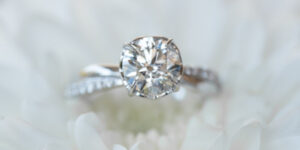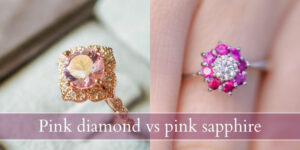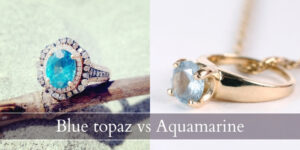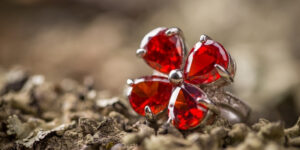Rectangular diamonds are a nice change from the traditional round brilliant, and two of the most famous rectangular diamonds are the emerald cut and the princess cut. Both offer clean, crisp lines and an angular look, but they do this differently and the sparkle factor is a whole other story. Choosing between these two diamond styles is not easy, so let us walk you through their key differences.
Please keep in mind that no amount of reading will equate to actually seeing and comparing two diamonds on your hand. We recommend finding a jeweler after reading this, to compare a princess and an emerald on your hand.
Emerald vs princess cut diamonds
Emerald cuts appear larger than princess cuts, since they are elongated rectangular cuts while the princess cut is a perfect square. Princess cuts are brilliant cuts which gives them high brilliance and a lot of fire, while emerald cuts offer far less sparkle but broader, larger flashes of light and color. Princess cuts are about 10% more expensive than emerald cuts, and offer a more modern look while emerald cuts are more of a classic, understated elegance.
Both the emerald cut and the princess cut have an angular look about them but they do this very differently. Which you choose will depend on your overall style, but we also recommend reading further for an in-depth comparison. First up, let’s explain what each of these diamond cuts is.
What is emerald cut ?
The emerald cut is a very old diamond cut style, derived from the old table cut. The shape is an elongated rectangle with the corners clipped off, a beveled crown and pavilion. The facets run parallel to each other, forming a sort of mirror effect. The only angled facets are the ones descending from the corners, and that is where more of the sparkle is. The best L/W ratio for emerald cuts is 1.30-1.50:1
Emerald cuts are not known for their sparkle, but rather for their subtle flashes of light. A more elegant, understated look when compared to the classic round brilliant. This is because the emerald cut is a step-cut diamond, and these types are meant to showcase a diamond’s clarity and color (or lack thereof) and cut quality.
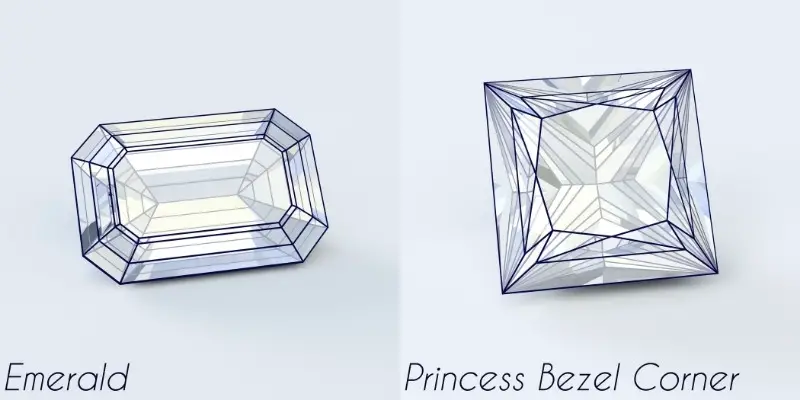
What is princess cut ?
The princess cut is comparatively new, only a few decades old. The shape is a square, usually a 1:1 L/W ratio. The pavilion has a series of chevron facets that form a sort of X in the middle of the diamond. This is a brilliant cut, as opposed to the emerald’s step cut. Brilliant cuts are meant for sparkle, and the princess cut has sometimes been called the squared brilliant due to its high brilliance, enough to rival a round brilliant.
This is the second most popular diamond cut, after the round brilliant. So you will easily find something that you like. Be warned that there are many, many variations on the princess cut, some with better fire than the traditional one, so a comparison may not always be accurate if you don’t know your exact princess variation.
1. Emerald cut diamonds are elongated, princess cuts are squares
Straight off the bat you’ll notice that princess cuts are square (or just a bit off-square) and the emerald cut is an elongated shape. The emerald cut is great for making fingers appear more slender, as is any elongated shape. An emerald may not work for everyone, some may fare better with an oval instead of something so linear. It really depends on the finger shape., but an emerald does tend to make the finger look slim and long.
Princess cuts don’t offer this, but instead they can be impressive in their shape. The square shape is not easy to wear but we’re sure there is someone who would be able to rock a princess cut.
And there is always the option of setting the stone on a diagonal for the princess or east-west for the emerald. There are a great way to take advantage of the shape of the diamond and make it look even more unique.
2. Princess cuts have more fire and brilliance than emerald cuts
Another thing you’ll notice immediately is the difference in fire and brilliance. Princess cuts are brilliant cuts, with many small facets and they are meant to sparkle like there’s no tomorrow. A princess cut has much smaller facets than an emerald cut, with smaller flashes of light, leading to more sparkle with fire (rainbow colors) and brilliance (white light).
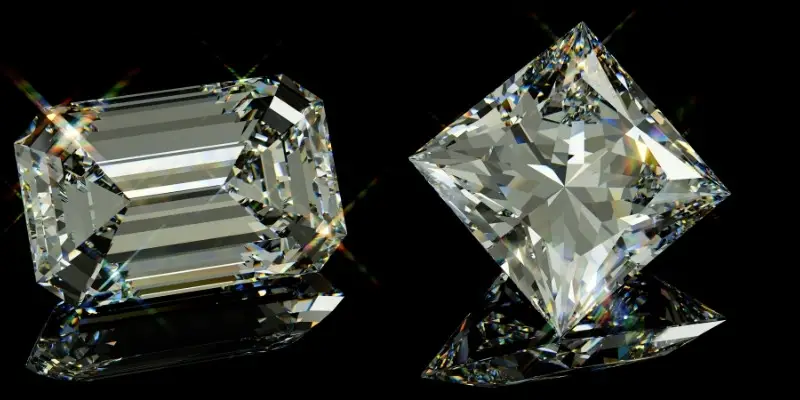
An emerald cut does sparkle too, but far less than a princess cut. Its longer, wider facets mean you get wide flashes of light, and thus fewer sparkles. It does have fire and brilliance but not nearly as much as a princess cut. If you’re looking for a step-cut that looks a lot like an emerald cut but has a bit more sparkle, try an Asscher cut.
3. Emerald cuts show color and imperfections, princess cuts are forgiving
Emerald cut diamonds have very large facets, and a wide table, allowing you to see into and sometimes through the diamond. And due to the way the facets are arranged any color the diamond has will be accentuated on the lateral facets (towards the girdle). This is also true for any inclusions the diamond might have.
For these reasons emerald cuts are really not something to toy with in terms of clarity and color. G is the lowest you can go with an emerald cut, and VVS1 for clarity. Of course, color is also impacted by the metal you’re setting the emerald cut in. So a G would be fine in rose or yellow gold, but for white gold or platinum you might want to stay in the D-F range.
As for princess cuts, these are brilliant cuts, tiny little mirrors, so they will splinter the image and hide most inclusions. The very tips of the princess might show a few, as they are thinner there and all facets come to a point at the corners. Color is also not a big problem with princess cuts since they are quite bright. A princess cut is always more forgiving than an emerald cut.
4. Princess cut diamonds are a more modern look than emerald cuts
If you’re considering the overall look of these diamonds, you should know that emerald cuts have more of a classic look to them. They’re the elegant, chic sort while the princess cut is much more modern. Maybe it’s the mix between a rectangular shape and a brilliant cut, or just the sharp corners, we’re not sure. But princess cuts definitely have a more modern feel to them when compared to emerald cuts.
If you’re set on an emerald cut but want to give it a new twist, consider an east-west setting.
5. Emerald cut diamonds appear larger than princess cuts
A nice thing about elongated diamond shapes, they always appear larger than squares or rounds of the same carat weight. This is because elongated shapes like the emerald cut carry their weight in their length. And an elongated shape will appear large simply because it is longer, it looks like it takes up more space on your finger than the princess cut.
So if you’re looking for a diamond cut that will appear larger, the emerald cut is a better choice than the princess cut.
6. Princess cut diamonds are more expensive than emerald cuts
There is a bit of a price difference between emerald cuts and princess cuts. The most expensive diamond cut is the round brilliant, yes, and all other diamond cuts are about 30-40% less in price. But the princess cut is about 10% more expensive than the emerald cut, simply because it is more popular and modern than the emerald cut.
Despite this, the amount of emerald cut diamonds available on the market is higher than princess cuts. So emerald cuts are nothing to sneeze at. They’re timeless and elegant, while princess cuts seem to be having a moment that could easily turn them into the next classic.
7. Emerald cuts have truncated corners, princess cuts have sharp corners
If you’re unsure about which is which, or want another factor, you should consider the durability of the diamond due to its shape. A princess cut always has sharp 90 degree corners that will snag or cut. They need protection because of this, in the form of a prong setting that covers all 4 corners, or a thin bezel setting that hugs the entire girdle of the diamond and covers the tips as well.
An emerald cut is more stable, precisely because its corners are clipped and its crown and pavilion are beveled. There are no sharp corners on an emerald cut, which make it safe to wear and offer no opportunity to chip the diamond. The most common (and elegant) setting for emerald cuts is the prong setting.

I’m the main author for jewelrymaterialguide.com. I started this site after we did tons of research before our wedding and noticed that there is information about rings, jewelry, and so on that is really hard to find on the internet.


